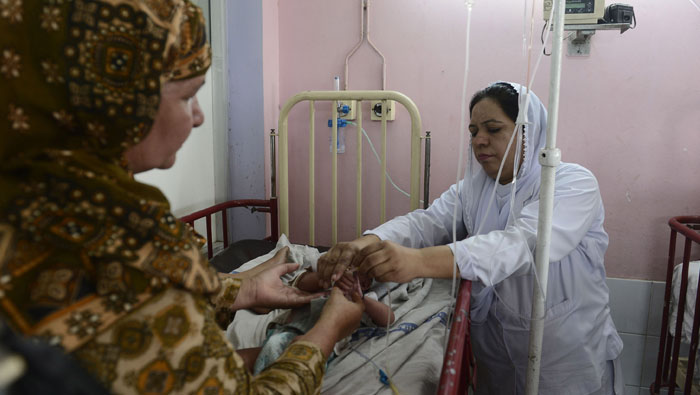
Geneva: More than 100,000 people died of measles in 2017, due to countries stopping and not taking sufficient care to enforce their vaccination programmes, the World Health Organisation has said.
Countries across the world reported spikes in measles outbreaks, leading to an estimated 110,000 deaths due to the disease.
The Americas, the Eastern Mediterranean and Europe were particularly hard hit, with the Western Pacific being the only region to register a drop in measles cases.
“The resurgence of measles is of serious concern, with extended outbreaks occurring across regions, and particularly in countries that had achieved, or were close to achieving measles elimination,” said Dr Soumya Swaminathan, Deputy Director General for Programmes at WHO.
“Without urgent efforts to increase vaccination coverage and identify populations with unacceptable levels of under-, or unimmunized children, we risk losing decades of progress in protecting children and communities against this devastating, but entirely preventable disease.”
The 2018 Assessment Report of the Global Vaccine Action Plan, which aimed to stop the spread of several diseases – including measles, rubella, maternal and neo-natal tetanus and wild poliovirus – said countries had rolled back some of their vaccination programmes after being lulled into a sense of false security, about the extent of how far their immunisation campaigns had spread.
“This year starkly illustrates how easily hard-won gains are lost,” said the report.
“Because of low coverage nationally, or pockets of low coverage, multiple WHO regions have been hit with large measles and diphtheria outbreaks causing many deaths.
To spur action, the Global Vaccine Action Plan set ambitious goals, and it remains the case that most targets will not be met by the end of the Decade of Vaccines in 2020.
“DTP3 (Diphtheria-tetanus-pertussis) and first-dose measles vaccine coverage have plateaued globally at 85 per cent,” it added.“Progress towards the eradication of wild poliovirus and the elimination of measles, rubella, and maternal and neonatal tetanus is currently too slow to be achieved by the end of the decade.”
While the Western Pacific Region has achieved its lowest ever incidence of measles and two countries were verified as having eliminated rubella, immunisation activities in the South East Asia Region averted an estimated 622,000 measles deaths in 2017.
However, 19.9 million children were under-vaccinated in 2017, four out of six regions experienced significant measles outbreaks and several countries and one region lost their measles elimination status.
Measles outbreaks in 2017 led to the Americas to lose its measles elimination status in 2018.
Between 2000 and 2016, measles vaccinations prevented an estimated 20.4 million deaths.
“Measles elimination took a step back in 2017,” added the report.“
Although the incidence of measles has more than halved since 2010, it increased in 2017 from 19 to 25 cases per million, with increases seen in four out of six WHO regions.
Significant outbreaks occurred across the globe, and a major outbreak in Venezuela, also affecting other countries in the region of the Americas, led to the re-establishment of endemic measles transmission in Venezuela.
The report said, “Outbreaks in North America and in Europe emphasize that measles can easily spread even in countries with mature health systems.Due to ongoing outbreaks, measles is again considered endemic in Germany and Russia. Measles outbreaks have been seen in countries reporting good national vaccine coverage, evidence of immunisation gaps and highlighting the need to ensure high sub-national coverage, particularly among vulnerable populations.”
WHO recommends the use of preventive measures such as routine vaccination programmes to stop the outbreak of such diseases, and adds that the cost of dealing with such an outbreak could be 20 times more expensive than preventing it.
“A deteriorating socioeconomic situation in Venezuela has had a significant impact on its health infrastructure, including its immunisation services,” the report stated.
“The resulting measles and diphtheria outbreaks have also spread to other countries in the region. Having been free of diphtheria for 24 years, Venezuela has now experienced more than 1600 suspected cases between 2016 and the middle of 2018.
The resurgence of measles has also led the region to lose its measles elimination status, just two years after it was secured in 2016.”
According to the United States’ Centre for Disease Control (CDC), measles’ symptoms include high fever, coughing, a runny nose and red eyes, which may indicate signs of conjunctivitis.
Once these early symptoms have been present for a couple of days, patients may develop white spots – also known as Koplik Spots – inside their mouths.
“Three to five days after symptoms begin, a rash breaks out. It usually begins as flat red spots that appear on the face at the hairline and spread downward to the neck, trunk, arms, legs, and feet,” said a CDC spokesman.
“Small raised bumps may also appear on top of the flat red spots. The spots may become joined together as they spread from the head to the rest of the body. When the rash appears, a person’s fever may spike to more than 104° Fahrenheit (40° Centigrade).After a few days, the fever subsides and the rash fades.”